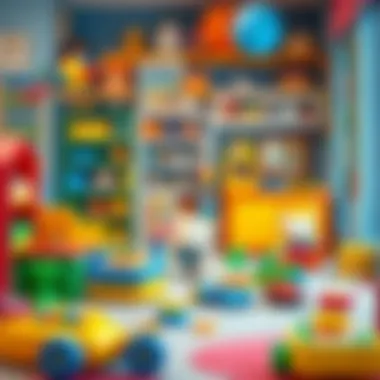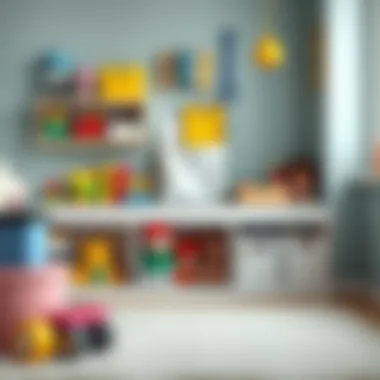Designing the Perfect Toy Nursery for Kids


Intro
Creating a nurturing and imaginative environment for children can seem like a daunting task. Nowadays, with the rise of multifunctional spaces, a toy nursery becomes not just a collection of toys, but a thoughtfully designed area that harmonizes play and learning. A well-planned toy nursery caters to children's developmental needs while keeping safety and aesthetics in mind. This guide serves to illuminate the essential components of designing such a space that works for everyone involved—children and caregivers alike.
When you think about toy nurseries, it is easy to envision a room overstuffed with colorful toys strewn about haphazardly. However, there’s so much more depth to consider, encompassing everything from furniture selection to organizational systems. This article delves into current design trends, buying guides, and practical tips to help you cultivate an engaging and functional toy nursery that fosters creativity.
We’ll discuss the latest trends in furniture styles that can transform any room into a welcoming play zone. We will also highlight how these trends can be tailored to fit your unique space. Additionally, we’ll explore the nitty-gritty of buying guides that inform what furniture works best in a toy nursery, and how assessing quality and value can lead to investments that withstand the rigors of childhood.
"The heart of a toy nursery shouldn’t just be toys; it should be a canvas that colors the early years of a child’s life."
By the end of this comprehensive guide, you will be armed with the knowledge to create an engaging environment that encourages exploration, creativity, and, most importantly, fun.
Understanding the Toy Nursery Concept
Creating a toy nursery is not just about throwing a few toys in a room and calling it a day. It's about understanding the deeper need for a dedicated space where creativity flourishes, learning thrives, and play is meaningful. A toy nursery can serve as a pivotal part of a child's development, and recognizing its significance is paramount for anyone involved in fostering a joyful environment for children, whether homeowners, designers, or enthusiasts.
Defining a Toy Nursery
So, what’s in a name? A toy nursery is more than a simple playroom; it combines functionality with creativity tailored specifically for children and their caregivers. Essentially, it is a multi-purpose space that should cater to various activities, including play, learning, and relaxation. Unlike generic play areas, a toy nursery is consciously designed to promote engagement and exploration.
A qualified toy nursery will often incorporate:
- Functional storage to keep toys organized and accessible
- Dedicated zones for different types of play—be it physical, imaginative, or educational
- Comfortable seating for caregivers to join in or supervise playtime \n The idea is to cultivate an enriching atmosphere, making the nursery a cornerstone for holistic growth.
Historical Perspectives on Play Spaces
Historically, play has evolved significantly. Back in the day, children played outside, using natural elements to foster imaginative play. Fast forward to today, and the concept of play spaces has changed drastically. In the early 20th century, educational philosophies emphasized play as critical for development, resulting in structured environments for children. Think of the iconic kindergartens that popped up, filled with blocks, crayons, and playful activities designed not only for fun but also for educational growth.
In more recent decades, research has continued to underline the importance of play. Various studies have shown that play facilitates essential skill development—social skills, problem-solving abilities, and even emotional intelligence. The modern toy nursery owes much to these growing understandings; it’s no longer just a place for absence of adult oversight but a carefully curated area that reflects the latest educational theories. Many contemporary toy nurseries incorporate elements of Montessori or Reggio Emilia approaches, encouraging self-directed learning and collaboration through thoughtfully placed toys and resources.
The evolution of playspaces highlights the ongoing responsibility adults hold in shaping environments where children can thrive. A well-planned toy nursery today can echo the intentions of historical play spaces by ensuring children have areas that stimulate and engage them.
By comprehending these roots not only do we gain insight into effective nursery design but we also ramp up our collective ability to nurture young minds through play, a fundamental building block for growth.
"Play is the highest form of research." - Albert Einstein.
As we continue to explore this topic, the underpinnings of the toy nursery concept reveal how imperative it is to balance aesthetic appeal with developmental efficacy. With this foundation, homeowners and designers can embark on their journey to create a space that is not only visually pleasing but deeply enriching.
Key Elements of a Toy Nursery
Creating a toy nursery is like mixing a dash of functionality with a sprinkle of creativity. It’s not simply about filling a space with bright colors and toys; it’s about crafting a haven where children can learn, play, and explore. The key elements of a toy nursery significantly impact how effectively it serves both children and their caregivers, offering safety, inspiration, and joy.
Choosing the Right Furniture
Storage Solutions
Storage solutions play a pivotal role in any toy nursery. They contribute significantly to keeping the space tidy and organized. Investing in ample storage options like colorful bins, drawers, or repurposed crates can make a world of difference. The key characteristic of such solutions is their ability to categorize toys, keeping everything in its place while being easily accessible to little hands.
A unique feature of storage solutions is their versatility. Not only can they hold toys, but they can also accommodate books, art supplies, and even soft furnishings. This multifunctional aspect can optimize the space effectively. However, it’s essential to choose bins that are sturdy yet lightweight, ensuring kids can help with cleanup without any mishaps.
Seating Arrangements
The seating arrangements in a toy nursery are crucial for comfort and social interaction. By selecting seating that is age-appropriate and comfy, you can encourage children to engage in collaborative play or read a book quietly. A key characteristic here is the adaptability of seating—think small cushy chairs or bean bags that can be moved around easily.
This flexible seating encourages a specific benefit: children can create their own cozy spaces, fostering independence and creativity. Special attention should be paid to selecting furniture with soft edges to minimize potential injuries. The drawback, however, is the necessity to ensure that these pieces are maintained, as wear and tear can result in safety concerns.
Play Areas
The play area is where all the magic happens. It’s vital to carve out designated play zones within the nursery, whether it’s a corner carpeted with plush rugs or a section with small tables for crafting. A standout feature of play areas is their potential for multipurpose use. They can easily transform from a quiet reading nook to a vibrant zone for imaginative play simply by shifting some cushions or adding different toys.
Investing in this area supports children's development through creative engagement and social interaction. However, one should be cautious about overcrowding this space with too many items, as clutter can hinder play rather than enhance it.
Incorporating Safety Features
Non-toxic Materials
Safety cannot be overstated when it comes to creating a chaotic yet safe environment for kids. Non-toxic materials should be at the forefront of your nursery design. They are crucial because children spend a lot of time playing on various surfaces and with different materials. One key characteristic of non-toxic choices is that they guarantee the health and safety of little ones; think organic cotton for soft toys or water-based paints for wall decoration.
The unique feature of opting for non-toxic materials is the peace of mind they bring. Parents can feel confident knowing that their children are playing on surfaces that won’t emit harmful chemicals. While the initial cost might be higher, the long-term benefits far outweigh this disadvantage, ensuring children's safety first.
Corners and Edges
Corners and edges of any furniture pose a risk for young children who are still finding their balance. Therefore, rounding edges wherever possible is a simple yet effective safety feature. Soft, rounded corners diminish the risk of injury significantly, especially when children are playing energetically. Choosing furniture specifically designed with safety features is a popular choice for parents who prioritize safety in play spaces.
The prominent advantage of utilizing rounded edges is the reduced chance of accidents. However, it’s also important to ensure that these modifications do not detract from the aesthetic appeal.
Flooring Considerations
Flooring considerations in a toy nursery should not be overlooked. It's essential to select a soft, non-slip surface that cushions falls, especially for toddlers learning to walk. Materials like foam tiles or plush carpets are beneficial because they provide comfort and safety. The unique feature of such flooring solutions is their ability to give children a safe space to explore while being easy to clean.
Opting for a type of flooring that absorbs sound can also maintain a peaceful environment. However, the disadvantage can stem from maintenance; certain materials require more frequent cleaning, particularly after messy play sessions.


"A safe space for children is a nurturing space, striking a balance between playfulness and precaution."
In summary, these key elements shape the overall experience and functionality of the toy nursery. From storage to safety measures, every decision made contributes to a nurturing environment where children can thrive.
Design Considerations for a Toy Nursery
When creating a toy nursery, it's essential to keep in mind that a well-designed space serves both functional and imaginative purposes. The design choices made within a toy nursery can significantly impact a child's play experience. In this section, we will delve into color schemes, aesthetics, and efficient space utilization, all crucial for crafting an engaging environment that fosters creativity.
Color Schemes and Aesthetics
Calm vs. Stimulating Colors
Choosing the right colors for a toy nursery isn't merely an aesthetic choice; colors play a crucial role in how children interact with their surroundings. Calm colors, such as soft blues, gentle greens, and pale yellows, can contribute to a sense of tranquility. On the other hand, stimulating colors like vibrant reds, sunny yellows, and electric blues can evoke energy and excitement.
A balanced mix of these hues can be a beneficial approach. For instance, employing calm tones on the walls produces a soothing backdrop, while splashes of brighter shades in decor items like rugs and cushions can spark enthusiasm and encourage exploratory play. The unique feature of this color strategy is versatility—it can adapt as children's moods and activities evolve, thus maintaining relevance over time.
However, overusing bright colors can sometimes lead to overstimulation, which might result in restless behavior. Hence, striking the right balance is crucial to harnessing the advantages while mitigating potential disadvantages.
Themes and Motifs
Integrating themes and motifs into the nursery can create a cohesive and engaging narrative in the space. These elements can allow children to feel connected to their environment. Popular themes, such as nature, outer space, or fairy tales, can provide inspiration and direction in play.
For example, a woodland theme featuring animal motifs can create a sense of adventure and exploration. Utilizing themed wallpaper or decals can transport a child into their fantasy world. One key characteristic of this approach is personalization—infusing a child's interests into the design fosters a sense of ownership over the space, likely encouraging imaginative play.
However, one must be wary of overly complex designs that might become easily dated as children's interests shift. Flexibility in implementing themes—like relying on removable decor—can help maintain the space’s freshness without complete overhauls.
Space Utilization Strategies
Maximizing Small Areas
In situations where space is at a premium, maximizing small areas becomes a necessity rather than an option. Creative approaches such as vertical storage solutions, wall-mounted toys, or convertible furniture can make a significant impact. An essential aspect of this strategy is the ability to create a child-friendly environment without feeling cramped.
Using under-bed storage or multi-functional pieces, such as ottomans that open for toy storage, can free up valuable floor space. However, this approach must be executed with careful planning, ensuring that the nursery remains accessible and safe for play.
Creating Zones
Dividing the nursery into distinct zones can enhance both functionality and play experience. Each zone can serve a different purpose, whether for quiet reading, active play, or creative pursuits like arts and crafts. This design choice provides children the option to choose their play experiences, supporting self-directed exploration.
Consider incorporating a reading nook with soft seating and bookshelves, separate from a crafting area laden with art supplies. A key characteristic of zone creation is clarity; clear labels can help kids understand the intended use of each zone. However, care must be taken to ensure that zones are adaptable, as a child's interests can change over time.
Organizing and Managing Toys
When it comes to a toy nursery, organizing and managing toys is like laying down the law in a bustling household. If left unchecked, toys can take over, turning a serene play space into a chaotic mess. A well-structured organization not only fosters a cleaner environment but also promotes learning and development through play. The importance of managing toys effectively cannot be overstated, as it equips children with the crucial skills of tidiness and responsibility, all while enhancing their ability to engage meaningfully with their toys.
Effective Storage Solutions
Baskets and Bins
Baskets and bins are the heroes of toy storage. Their flexibility and design make them a perfect fit for a toy nursery. Available in various sizes and materials, they can neatly corral all types of toys, from small action figures to larger stuffed animals. The key characteristic that makes baskets and bins popular is their ability to blend in with the decor while maintaining functionality.
Unique Features: Many baskets come with lids or handles, allowing for easy transport and discreet storage. They can be made from natural materials like wicker, which adds a rustic touch, or from plastic, offering durability and ease of cleaning.
Advantages and Disadvantages: While baskets can be aesthetically pleasing, they may require more frequent cleaning if used for items like art supplies that can spill. Still, the benefits they provide in ease of access to toys far outweigh the downsides.
Shelving Units
Shelving units stand tall as exemplary storage solutions for a toy nursery. They not only utilize vertical space but also allow for a clear view of what’s available for play. This visibility encourages children to pick their toys independently, fostering decision-making skills. The key characteristic of shelving units is their ability to organize toys into categories, which can be based on type, size, or theme.
Unique Features: Many shelving systems come with adjustable shelves to accommodate toys of various heights, making them adaptable as children grow. Advantages and Disadvantages: The disadvantage is that shelving units can become cluttered if toys are not returned to their designated spots. Therefore, setting guidelines about organization is essential; otherwise, they may become just another dumping ground.
Display Options
Display options often bring a creative flair to organizing toys while double as decor. Think open shelving where toys can be shown off like trophies. They invite curiosity and interest from both children and visitors, enhance the visual appeal of the nursery, and encourage interactive play. The key characteristic is that display options allow children to appreciate their toys and engage with them more intentionally.
Unique Features: Some display solutions offer transparent bins or frames that show off beloved toys while keeping them easily accessible. Advantages and Disadvantages: While showcasing toys nicely presents an element of pride, it can also lead to dust accumulation. Therefore, regular cleaning can mitigate this issue, ensuring that the display remains as appealing as when it first began.
Toy Rotation Systems
Managing toys goes beyond merely putting them away; it's about knowing when to introduce and retire them to maintain a child's interest. This is where toy rotation systems come into play.
Benefits of Rotation
The beauty of a toy rotation system lies in its inherent ability to spark renewed interest in toys. By only having a portion of toys available at any given time, children are likely to engage with them more deeply. The key characteristic of the benefits of rotation is that it not only prevents overwhelm but also fosters creativity by prompting children to rediscover their toys.
Unique Features: A rotating system can naturally lead to less clutter while encouraging mindfulness in play.
Advantages and Disadvantages: However, some parents may face challenges in keeping track of what toys should be rotated and when, but with an established schedule, this can easily be managed.
Implementing a Schedule
Having a clear plan for toy rotation adds structure to an otherwise chaotic process. The key characteristic of implementing a schedule is greater predictability, making it easier for both parents and children to know what to expect.
Unique Features: A simple calendar or app can track when toys should be rotated out and stored away. This takes the guesswork out of the process, ensuring that toys remain exciting. Advantages and Disadvantages: The only drawback might be if children become attached to certain toys and resist change. Knowing that favorites will return soon can help ease transitions.
A well-organized toy nursery is not just about aesthetics; it's about creating an environment that nurtures learning, creativity, and independence in children.
Promoting Development Through Play


Creating a toy nursery is not merely about aesthetics or keeping a tidy space for toys; it also plays a key role in nurturing a child's development. Play is essential for children as it influences cognitive, social, and emotional growth. The various elements involved in play are not just random acts of childhood but foundational experiences that shape future skills and behaviors.
A well-designed play space encourages exploration and imaginative play, which are pivotal for learning. It’s essential that every component – from the types of toys selected to the layout of the room – is oriented towards fostering such development.
Selecting Developmental Toys
Cognitive Benefits
Cognitive development through play is all about enhancing a child’s ability to learn, reason, and solve problems. Toys that challenge children encourage critical thinking and promote understanding of cause-and-effect relationships. For example, building blocks or puzzles not only sharpen spatial skills but also engage logical thinking.
The hallmark of cognitive toys is their ability to foster curiosity. Children learn by doing and experimenting, and these toys provide a platform for such learning. As a result, cognitive toys are a popular choice for many parents. Their advantage lies in facilitating strategic thinking while being engaging. Yet, some parents worry about the potential for frustration if a toy is too complex for their child.
Physical Engagement
Physical engagement is crucial for a child's health and development. Toys that require movement, like tricycles or balls, support the development of gross motor skills. These activities improve coordination and strength, which are essential for daily activities.
The key characteristic of physical engagement toys is their ability to get kids active. They also promote social play, especially when children engage with peers in a game of catch or tag. The upside to this type of play is obvious in terms of health benefits, but a downside could be the requirement for safe outdoor spaces, which can sometimes be a challenge to provide.
Creative Expression
When children are allowed to explore their creativity, it significantly enhances their emotional and social skills. Toys that promote creative expression, such as art supplies and role-playing kits, encourage children to express themselves and develop their imagination.
These toys are particularly beneficial in that they allow for unstructured play, fostering a sense of independence and decision-making. The unique aspect is the freedom it gives kids to create their own environments or narratives. However, the downside might include the mess created during play, which can be daunting for some caregivers.
Creating Engaging Play Spaces
An engaging play space is essential for promoting development as it creates an environment that children cannot resist exploring. It’s all about thoughtful design that encourages active participation.
Interactive Stations
Interactive stations, such as sensory tables or science kits, provide hands-on experiences that invite kids to explore and investigate. These setups can engage multiple senses and cater to different learning styles, making them a beneficial addition to any nursery.
The distinctive feature of interactive stations is that they can be easily modified based on the child's interests. For instance, you can rotate materials and themes to keep the play fresh and stimulating. Thus, they cater to ongoing learning. However, one might find that maintaining such stations requires regular updates, which could be time-consuming.
Sensory Areas
Incorporating a sensory area in the toy nursery helps children process information through sensory experiences. This might include textured mats, water play stations, or soft cushions. These areas help with sensory integration, allowing kids to explore various textures, smells, and sounds.
Sensory spaces are great for all children, especially those with sensory processing disorders. They provide unique advantages, such as spawning calmness and focus. Yet, the challenge lies in creating a separate and safe area designated for this type of play, which may take extra resources or space.
When children are provided with engaging play spaces, they not only learn more but they also enjoy the process, merging fun with educational value.
Sustainability in Toy Nursery Design
Designing a toy nursery with sustainability in mind is crucial, not just for the environment but also for fostering a safe and healthy space for children to play. The importance of eco-friendly practices can hardly be overstated in today’s world, where consumption habits and resource depletion are pressing issues. When it comes to nurturing young minds and encouraging creative play, integrating sustainability into the nursery's design can produce immense benefits, such as reducing your carbon footprint and teaching children important values about caring for their environment.
Choosing sustainable methods means looking beyond aesthetics. For homeowners, designers, and retailers, wholistic thinking about materials, furniture, and even toy selection can turn a toy nursery into a model for eco-friendly living. By making informed choices, you can contribute to a brighter future while cultivating a safe nurturing atmosphere for your child to grow.
Sustainability in design touches on various facets: from the environmental impact of materials to the lifecycle of toys and furnishings. By examining the significance of eco-friendly materials and opting for second-hand options, we can construct a nursery that reflects a commitment to sustainability.
Eco-friendly Materials
When it comes to building a sustainable toy nursery, selecting eco-friendly materials is a fundamental step. This doesn't just mean picking anything labeled "green". It involves digging a little deeper into the sourcing and manufacturing processes of each item. Look for materials that are:
- Non-toxic – These are crucial for ensuring your child's safety. Materials like organic cotton, bamboo, or low-VOC finishes for furniture can significantly reduce exposure to harmful chemicals.
- Renewable and Recyclable – Wood sourced from responsibly managed forests or recycled plastics can make a profound difference. Opting for these materials means supporting industries that prioritize the planet.
- Durable – Choosing high-quality, long-lasting items means you won’t need to replace them frequently. This notion is not just wise economically but also physically and conceptually.
By opting for eco-conscious materials, you are making a long-term investment in both your child’s safety and the environment. Every choice you make resonates beyond mere aesthetics; it can mold young minds and instill in them the values of sustainability.
Second-hand Toys and Furnishings
Another important pillar of sustainability is the willingness to embrace second-hand toys and furnishings. Nowadays, many parents and designers may be hesitant about using pre-owned items, but there are several advantages worth considering.
- Cost-effectiveness – Buying second-hand can save considerable sums and allows for purchasing higher-quality items that might be beyond your budget when bought new.
- Unique Finds – Vintage toys and furniture can lend character and charm to the nursery. Often, these items have stories of their own, provoking curiosity and imagination in children.
- Environmental Impact – Each toy or piece of furniture saved from the landfill is a plus for the planet. By reusing items, you contribute to reducing waste.
Incorporating second-hand items doesn’t have to mean compromising on safety or aesthetics. It can lead to an eclectic mix that reflects both personality and responsibility. Lastly, it’s a wonderful way to connect with the community through local thrift shops, swaps, or online marketplaces. If you’re unsure about the condition of an older item, be sure to inspect it thoroughly or sanitize it properly before bringing it into your nursery.
In essence, when crafting a toy nursery, thinking sustainably opens a plethora of possibilities that don’t just benefit the current generation but also set forth a legacy of care and respect for the world our children will inherit.
Creating a sustainable toy nursery is more than a choice; it’s a commitment to fostering a better environment for future generations.
For further insights into eco-friendly living, take a look at the following resources:
By navigating the realms of eco-friendliness, your decisions will echo through both the immediate space of the nursery and the larger context of the world.
Technology Integrations in Toy Nurseries
In today's fast-paced world, technology integration in toy nurseries holds a growing significance. As more families embrace digital tools as part of everyday life, incorporating technology in play spaces becomes essential not just for convenience, but also for enhancing educational experiences. From electronic toys to interactive apps, technology plays a crucial role in creating a dynamic and engaging environment for children. The key is to balance these innovations with safety considerations, ensuring that technology supports development rather than overwhelms it.
Educational Apps and Tools


With the vast array of educational apps available, parents and caregivers find themselves faced with excitement and challenge alike. The right apps and tools can foster creativity, critical thinking, and collaborative play. Here are some pivotal aspects to consider:
- Interactive Learning: Applications like Endless Alphabet or ABCmouse introduce language and numbers through gamified experiences. Children can explore these concepts at their own pace, making the learning process enjoyable.
- Creative Expression: Apps such as Toca Boca allow kids to engage in imaginative scenarios, reinforcing problem-solving skills and creativity. Through virtual role-playing, children can explore new roles and stories, adding depth to their playtime.
- Parental Involvement: Many platforms encourage parents to partake in interactive learning sessions. This shared experience not only strengthens the parent-child bond but also allows caregivers to gauge developmental progress.
Implementing these educational tools can add a layer of depth to your toy nursery. However, it’s critical to choose age-appropriate applications to ensure they align with the developmental stage of the child.
Safety in Tech Use
While technology provides numerous benefits, safety must always be the top priority. As exciting as an app or smart device might be, the potential hazards must be addressed effectively. Here are some safety considerations:
- Screen Time Guidelines: Experts recommend that children aged 2 to 5 years be limited to one hour of high-quality programming each day, ensuring a balance between digital and physical play.
- Privacy and Security: With many apps requiring personal data, parents should be vigilant in choosing platforms that respect user privacy. Look for apps that are COPPA compliant (Children's Online Privacy Protection Act) to ensure children's information is protected.
- Physical Safety: Ensure that any tech devices are suited for children, with no small parts that could pose choking hazards. Height and layout of tech stations should be child-friendly, and cords should be secured to avoid tripping.
"Integrating technology into a toy nursery isn’t just about having the latest gadgets; it’s about enhancing the environment for growth and exploration, safely and thoughtfully."
By carefully selecting educational apps and tools while keeping a keen eye on safety, caregivers can create a toy nursery where technology and creativity harmoniously coexist. This balance ensures that children can explore both the digital and physical aspects of play, leading toward a holistic development experience.
Personalized Aspects of a Toy Nursery
Creating a toy nursery that truly resonates with a child's personality and family values involves a heartfelt touch. Personalization in design not only heightens the aesthetic appeal but also strengthens the emotional connection children have with their play environment. By incorporating personalized elements, caregivers can foster a sense of belonging and ownership in their little ones, encouraging them to engage more deeply with their toys and spaces.
Incorporating Personal Touches
Family Photos
Family photos serve as meaningful reminders of love and belonging. These snapshots can be displayed prominently, creating a vibrant wall that reflects the joy of family life. When children see photos of their closest relatives, it can cultivate a sense of security and warmth within the nursery. It's a way of bringing familiar faces into the play area, making the space not just a place to play, but a comforting haven.
The unique feature of using family photos lies in their powerful storytelling ability. Each image holds memories that can spark conversations and connect children with their family history. However, it’s essential to strike a balance between decor and clutter; too many photos can overwhelm a space. Instead, selecting a few key images that can be rotated periodically keeps the atmosphere fresh and engaging.
Customized Decor
Customized decor is another aspect that can elevate the toy nursery from ordinary to extraordinary. This could encompass anything from hand-painted murals to personalized name banners. Such elements not only showcase a child’s personality but also express their interests. For example, if a child loves dinosaurs, adding a mural of a prehistoric scene can ignite their imagination.
One noteworthy characteristic of customized decor is its uniqueness. It ensures that the nursery feels distinctly theirs, setting it apart from mainstream designs. Nevertheless, it's important to remember that while personalization enriches aesthetics, it should not overshadow functionality. A delicate balance is vital; decor must remain practical and safe for playtime activities.
Cultural Influences in Toy Selections
When crafting a toy nursery, recognizing the cultural influences in toy selection can enhance the child’s learning and growth. Different cultures have varied approaches to play and learning, and integrating these aspects can nurture a more inclusive environment.
Parents can consider incorporating toys that reflect their heritage, whether it’s traditional dolls, games, or educational tools that teach a language. This can help in teaching children about diversity and imparting values related to their culture. Furthermore, toys that recognize and celebrate cultural heritage can make children feel valued and understood, allowing for a richer play experience.
Maintaining the Toy Nursery
Creating a toy nursery goes beyond initial setup; ongoing maintenance is the bedrock for ensuring that this vibrant space remains both functional and in tune with your child's evolving needs. Regular upkeep of toy nurseries plays a crucial role in fostering a safe and engaging environment, which actively supports a child’s growth and development.
A well-maintained nursery not only keeps toys in good condition but also encourages children to take part in the organization and care of their own play space. This experience deters the chaos that often arises in play areas and instills a sense of responsibility in little ones. Plus, a tidy room is easier for caregivers to supervise, making playtime as stress-free as possible.
Regular Cleaning Routines
Implementing a regular cleaning routine in the toy nursery is essential. Toys collect dust, crumbs, and other grime, which can be detrimental to a child’s health if not managed properly. Here are some key considerations for an effective cleaning regimen:
- Weekly Cleaning: Establish a day each week solely dedicated to cleaning. This should include wiping surfaces, vacuuming, and sanitizing toys.
- Toy Care: Different types of toys require different cleaning methods. For example:
- Organizational Check: While cleaning, take the opportunity to assess toy organization. Are toys still age-appropriate? Need any of them to be rotated out or replaced?
- Health and Safety: Use non-toxic cleaners to maintain a safe environment, and don’t forget to inspect smaller items for wear and tear—these may pose choking hazards.
- Plush toys can usually be tossed in the washing machine, following manufacturer instructions.
- Plastic toys should be soaked in a mild soap solution and rinsed well.
Updating for Growth Stages
As children grow, so do their interests and developmental needs. Updating the toy nursery is a fundamental aspect of maintaining this dedicated play space. Here’s how to approach this task:
- Age-Appropriateness: Regularly evaluate the toys available. Replace those that no longer meet your child’s developmental stage. Educators and child development experts often suggest toys that evolve with a child’s skills. For instance, toys that encourage imaginative play are great for toddlers but may need to be swapped out for more complex games as the child matures.
- Feedback from the Child: Engage your child in the decision-making process. Ask for their favorites and involve them in sorting through toys to determine what stays and what goes. This can make the transition smoother and instill confidence in their choices.
- New Additions: Look for toys that cater to emerging interests. If your child shows a penchant for building, consider small sets of blocks or other construction-related toys. This keeps the environment engaging and promotes continued exploration.
- Header detours: Also consider the leap into aesthetic and thematic updates, such as changing the decor reflected in their evolving tastes—a space that mirrors their transition from toddler to preschooler creates an inviting atmosphere that nurtures creativity.
By ensuring the cleanliness and relevancy of the toy nursery, you create a rich, inviting space that invites creativity and fosters learning. Regular maintenance and timely updates keep both the toys and the nursery itself in excellent shape, providing an environment where children can thrive.
"A space is only as good as the care put into it. Invest time in maintaining your nursery for lasting impact."
For more insights on toy safety and cleaning standards, refer to official resources like the Consumer Product Safety Commission and learn about best practices for toy care at KidsHealth.
The sum of these maintenance strategies should set a solid foundation for a toy nursery that is not just visually appealing, but also functional and safe.
Future Trends in Toy Nurseries
In the continually evolving landscape of design and early childhood development, the concept of toy nurseries has witnessed significant transformations. Understanding future trends in toy nurseries is not merely about keeping up with style; it's about anticipating the needs of the young generations. As our world becomes increasingly intertwined with technology and awareness of sustainability grows, these trends offer insights that impact how we create adaptable, engaging, and nurturing environments for children.
Innovative Designs
Innovative designs are reshaping toy nurseries, blending aesthetics with practicality in ways that promote both play and learning. The focus now is on multi-functional spaces that can evolve alongside a child's growth. Here are a few key points to consider:
- Modularity and Flexibility: Toy nurseries are embracing modular furniture that can be rearranged as kids grow. For instance, a block of storage bins might transform from a simple toy organizer to a seating area with cushions added. This flexibility supports the child’s developmental stages, adapting to their changing needs.
- Nature-inspired Elements: Many designers are incorporating biophilic design principles, bringing elements from nature indoors. This can be as straightforward as introducing plants or using natural wood for furnishings. It’s about fostering a connection to the natural world, which has been shown to promote mindfulness and creativity.
- Interactive Surfaces: Desks and tables designed with chalkboard paint or whiteboard surfaces encourage free expression. Children can sketch, write, or even play games directly on the surface, making ordinary furniture an integral part of their creative process.
The idea is that every piece in the room should encourage exploration and innovative thinking.
Evolving Toy Preferences
As children grow and the market changes, so do the types of toys they are drawn to. This evolution can significantly influence the design and organization of a toy nursery. Here are some trends currently observed in toy preferences:
- STEM-Related Toys: There is a marked shift toward toys that promote science, technology, engineering, and math. Companies are designing engaging puzzles, building kits, and robotic toys that not only entertain but also instill critical thinking skills from an early age.
- Sustainability in Toys: Parents today are increasingly aware of the environmental impact of their purchases. Toys made from recycled materials or sustainably sourced wood are becoming more common. This shift not only affirms children's play preferences but also teaches them the value of caring for their environment.
- Nostalgic Play: In a digital age, there’s a rising demand for toys that encourage imaginative pretend play—like kitchen sets or doctor kits. This yearning for nostalgia can help children connect with their parents’ experiences, fostering conversations and shared playtime.
In the context of these evolving tendencies, it’s essential to remain vigilant and adaptable. As priorities shift in society, so too will the designs and elements that comprise toy nurseries, ensuring they can continue to nurture and inspire the next generation.















